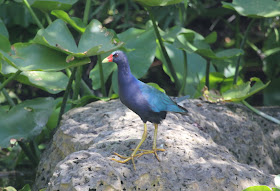 Have I got your attention now?
Have I got your attention now?If you haven’t already read Part I of my Florida trip, please scroll down and have a look if you like. This entry will pick up at The Everglades, our next destination after Fort Myers. Yes, Virginia, there are alligators there!
The Everglades is known as the “River of Grass,” which describes it perfectly; it is actually a shallow, slow-moving, freshwater river nearly 50 miles wide! A lot of people are surprised when they go there to see that it is not a tropical jungle or a deep, dark swamp, but rather a flat, very flat wet grassland. The grasses are an efficient, natural filter for all the water that drains from Florida into the ocean. The highest elevation in the park, which encompasses 1,506,539 acres, is 6 feet! But a few inches of elevation in the Everglades makes a world of difference in the vegetation; hardwood hammocks grow in thick clusters wherever the elevation rises ever so slightly, and there exotic species of plants, trees and wildlife thrive.
Much of The Everglades is not accessible to people, or is accessible only by boat. This is a blessing, as human presence could only do more damage to the fragile ecosystem and its wildlife. It’s probab
 ly a blessing to the humans too, as the insects, reptiles and other residents of the park can become absolutely unbearable to people, especially as the weather warms up. But those who want to can experience a good sampling of the Everglades by walking the trails, boardwalks and side roads that the park has built. The easiest and most “people-friendly” of the trails is probably the Anhinga Trail.
ly a blessing to the humans too, as the insects, reptiles and other residents of the park can become absolutely unbearable to people, especially as the weather warms up. But those who want to can experience a good sampling of the Everglades by walking the trails, boardwalks and side roads that the park has built. The easiest and most “people-friendly” of the trails is probably the Anhinga Trail. The Anhinga, for which the trail is named, is actually a water bird that is very common in the Everglades. It’s reminiscent of a cormorant, but is much thinner and sleeker, with a long, thin dagger-like bill that it uses to pierce its prey. The picture above is of two fledglings near the nest that aren’t quite ready to fly. A few Anhingas do occur in Virginia, but nowhere near the numbers you’ll find farther south.





The Queen (above) looks a lot like a Monarch, and they are members of the same family, but once you study butterflies a little bit, you’ll see subtle differences. The Queen is a darker color of orange, with more brownish tones, and if you look at the underside of the forewing you’ll see there are no black veins like there are on the Monarch. Like Monarchs, they lay their eggs on plants that are in the milkweed family, which the caterpillars eat until they go into their chrysalis stage.
One of the butterfly species that I really wanted to see badly was the Mangrove Skipper, a subtropical species that only reaches North America in Florida. Its host plant is the Red Mangrove tree. My efforts in walking Snake Bight Trail were rewarded when I finally saw one of these beauties and was able to photograph it. Here are a couple of photos: I especially like the one where it’s looking straight into the camera!





 Everyone has heard of "meadowlarks" but few have really seen one up close. This beautiful bird with the bright yellow throat and breast is an Eastern Meadowlark. The species is common in Virginia and much of the eastern half of the United States. Yes, there is also a Western Meadowlark, which is very similar in appearance to its eastern cousin, and it inhabits the areas west of the Great Plains. Meadowlarks are renowned for their beautiful songs.
Everyone has heard of "meadowlarks" but few have really seen one up close. This beautiful bird with the bright yellow throat and breast is an Eastern Meadowlark. The species is common in Virginia and much of the eastern half of the United States. Yes, there is also a Western Meadowlark, which is very similar in appearance to its eastern cousin, and it inhabits the areas west of the Great Plains. Meadowlarks are renowned for their beautiful songs. Here's a bird that does not occur in Virginia. The Crested Caracara occurs only in Florida, Texas and Arizona in the United States, and southward into the tropical areas of Central and South America. Although it is actually a member of the falcon family of birds, it readily eats carrion like vultures do, and it is nicknamed the Mexican Eagle. It is a striking bird-- just look at that beak!
Here's a bird that does not occur in Virginia. The Crested Caracara occurs only in Florida, Texas and Arizona in the United States, and southward into the tropical areas of Central and South America. Although it is actually a member of the falcon family of birds, it readily eats carrion like vultures do, and it is nicknamed the Mexican Eagle. It is a striking bird-- just look at that beak!


 This Black-bellied plover is also a species that we see regularly in Virginia. Like the Turnstone, its winter coloration is much duller than it is in the breeding season. The plovers are another family of shorebirds that you'll almost always find near the water or wet fields.
This Black-bellied plover is also a species that we see regularly in Virginia. Like the Turnstone, its winter coloration is much duller than it is in the breeding season. The plovers are another family of shorebirds that you'll almost always find near the water or wet fields.
